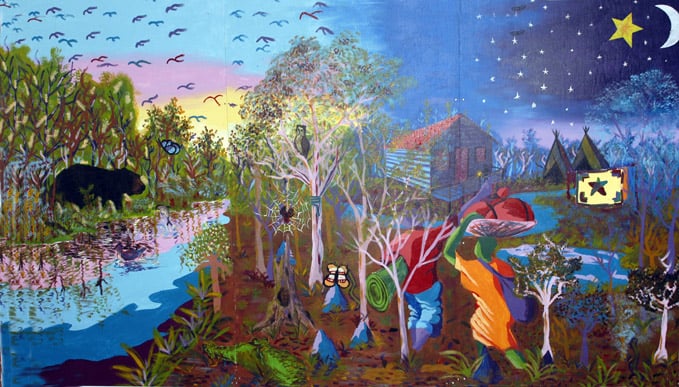Tunde’s Art
The Great Dismal Swamp has provided inspiration to a long list of literary figures and artists over the past 300 years. Henry Wadsworth Longfellow and Harriet Beecher Stowe have most notably written about the swamp’s role as a hiding place for freedom seekers and fugitives. Camden County’s newest African American Heritage Brochure features beautiful artwork from Tunde Afolayan-Famous’ Passage: Echoes of the Great Dismal Swamp, Underground Railroad Series.
 Underground Railroad Mural-Trigg Elementary School
Underground Railroad Mural-Trigg Elementary School
Tunde Afolayan was born in Nigeria and graduated from the prestigious “Yaba School”. This accomplished artist and educator continues to make a significant impact on the lives of adults and children through his artwork, workshops, demonstrations and school residencies. His paintings are displayed in private and corporate collections throughout the world.
Tunde’s Underground Railroad Series began in 2004 at Trigg Community School in Elizabeth City as part of an Art in Education residency. His experience with the students produced the Underground Railroad Mural, a visual account based on the history of the Dismal Swamp.
Tunde states, “ I explored North Carolina’s natural forms, beauties, mysteries and historic realities with the elements of color, space and texture to express my fascination with structured improvisation and poetic metaphors. “ The Great Dismal Swamp was a known route and destination for freedom seekers. The morass of huge trees towering over dense underbrush made it possible for large colonies to establish permanent refuge in this natural area.


In 2003, the Dismal Swamp State Park, Dismal Swamp Canal Welcome Center, Dismal Swamp Canal and Great Dismal Swamp National Wildlife Refuge were included on the National Park Service’s National Underground Railroad Network to Freedom Program. Wanda Hunt-McLean, retired professor from Elizabeth City State University, spent two decades researching Underground Railroad history in northeastern NC and is responsible for obtaining the swamp’s designation. Documentation proves the Great Dismal Swamp was used by more escaping slaves than any other swamp or forest in the South.
Learn more about Tunde Afolayan-Famous’ artwork and visual arts residencies by visiting http://www.tundevisualart.com/.
